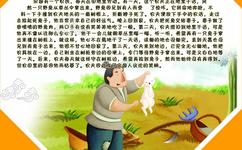一、守株待兔英语怎么说?最直接的翻译
“守株待兔”最简单的翻译就是 wait for a hare by a tree stump。 简单直接,容易理解。 但这个翻译略显生硬,缺乏汉语成语的韵味和文化内涵!

二、 如何用英语表达“守株待兔”的比喻意义?
咱们老祖宗说的“守株待兔”,可不是字面意思,说的是一种死板、不灵活的做法。 要表达这种比喻意义,就要考虑语境。 以下是一些更贴切的选择:
- To stick to outdated methods; to cling to a past success. 这句话更强调“墨守成规,固步自封”!
- To rely on luck instead of effort. 这句话则点出了“守株待兔”中盲目依赖偶然性的本质!
- To miss the bigger picture while focusing on minor gains. 这句话则侧重于只顾眼前的蝇头小利,而忽略了大局!
三、 用英语解释“守株待兔”的故事及寓意
要是想详细解释这个故事,可以这么说:
The idiom "Waiting for a hare to bump into a tree stump (守株待兔)" tells the story of a farmer who accidentally caught a hare by a tree stump. Instead of continuing his work, he foolishly sat there expecting to catch another hare the same way. This highlights the importance of hard work and not relying on accidental success. It's a perfect example of how being overly rigid and complacent can lead to failure.
The story of the 守株待兔 exemplifies the folly of relying on chance rather than planning and effort. It teaches us the need for adaptable strategies.
四、 不同语境下“守株待兔”的英文表达
咱们在不同场合说“守株待兔”,侧重点也可能不一样。 例如:
- 商务场合: 如果想批评别人墨守成规,可以用 “This is a 守株待兔 strategy and will ultimately lead to failure.” 或者更委婉的 “We need to be more proactive and innovative; clinging to old methods isn't sustainable.”
- 日常口语: 跟朋友聊天,你就可以用更简单的说法: “That’s like waiting for a hare by a tree stump!” 或者 “Don't be a 守株待兔; we need to work harder for a more reliable outcome.”
五、 “守株待兔”英文表达的小结与感悟
我个人觉得,“守株待兔”的英文表达并没有一个完美的、可以涵盖所有语境的单一翻译。 最恰当的表达取决于具体的语境和你想强调的重点。 就像今年是龙年一样,不同的龙有不同的寓意,而“守株待兔”的英文表达也需要我们灵活运用,才能表达出其精髓。 有时候,一个简单的例子比任何长篇大论都更有说服力,毕竟“实践出真知”嘛! 别再“守株待兔”式地等待机会了,主动出击,才是王道!


